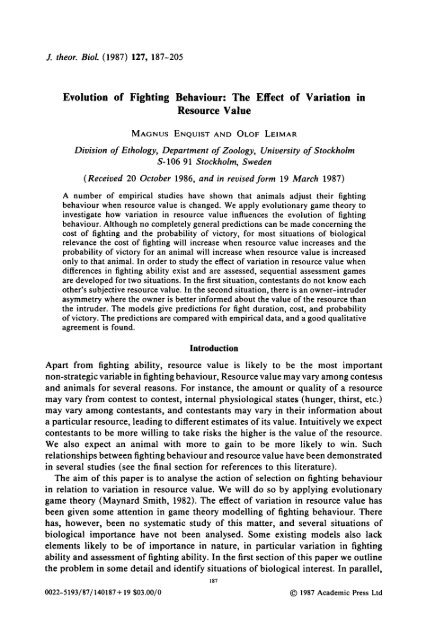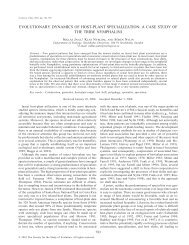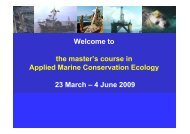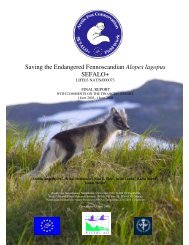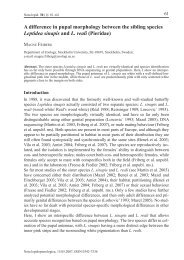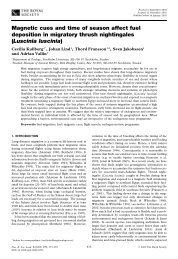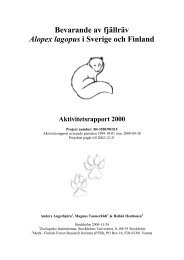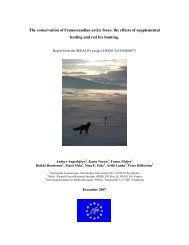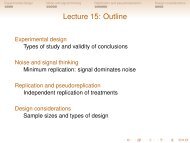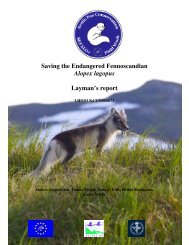Evolution of Fighting Behaviour: The Effect of Variation in Resource ...
Evolution of Fighting Behaviour: The Effect of Variation in Resource ...
Evolution of Fighting Behaviour: The Effect of Variation in Resource ...
Create successful ePaper yourself
Turn your PDF publications into a flip-book with our unique Google optimized e-Paper software.
J. theor. Biol. (1987) 127, 187-205<strong>Evolution</strong> <strong>of</strong> <strong>Fight<strong>in</strong>g</strong> <strong>Behaviour</strong>: <strong>The</strong> <strong>Effect</strong> <strong>of</strong> <strong>Variation</strong> <strong>in</strong><strong>Resource</strong> ValueMAGNUS ENQUIST AND OLOF LEIMARDivision <strong>of</strong> Ethology, Department <strong>of</strong> Zoology, University <strong>of</strong> StockholmS-106 91 Stockholm, Sweden(Received 20 October 1986, and <strong>in</strong> revised form 19 March 1987)A number <strong>of</strong> empirical studies have shown that animals adjust their fight<strong>in</strong>gbehaviour when resource value is changed. We apply evolutionary game theory to<strong>in</strong>vestigate how variation <strong>in</strong> resource value <strong>in</strong>fluences the evolution <strong>of</strong> fight<strong>in</strong>gbehaviour. Although no completely general predictions can be made concern<strong>in</strong>g thecost <strong>of</strong> fight<strong>in</strong>g and the probability <strong>of</strong> victory, for most situations <strong>of</strong> biologicalrelevance the cost <strong>of</strong> fight<strong>in</strong>g will <strong>in</strong>crease when resource value <strong>in</strong>creases and theprobability <strong>of</strong> victory for an animal will <strong>in</strong>crease when resource value is <strong>in</strong>creasedonly to that animal. In order to study the effect <strong>of</strong> variation <strong>in</strong> resource value whendifferences <strong>in</strong> fight<strong>in</strong>g ability exist and are assessed, sequential assessment gamesare developed for two situations. In the first situation, contestants do not know eachother's subjective resource value. In the second situation, there is an owner-<strong>in</strong>truderasymmetry where the owner is better <strong>in</strong>formed about the value <strong>of</strong> the resource thanthe <strong>in</strong>truder. <strong>The</strong> models give predictions for fight duration, cost, and probability<strong>of</strong> victory. <strong>The</strong> predictions are compared with empirical data, and a good qualitativeagreement is found.IntroductionApart from fight<strong>in</strong>g ability, resource value is likely to be the most importantnon-strategic variable <strong>in</strong> fight<strong>in</strong>g behaviour, <strong>Resource</strong> value may vary among contestsand animals for several reasons. For <strong>in</strong>stance, the amount or quality <strong>of</strong> a resourcemay vary from contest to contest, <strong>in</strong>ternal physiological states (hunger, thirst, etc.)may vary among contestants, and contestants may vary <strong>in</strong> their <strong>in</strong>formation abouta particular resource, lead<strong>in</strong>g to different estimates <strong>of</strong> its value. Intuitively we expectcontestants to be more will<strong>in</strong>g to take risks the higher is the value <strong>of</strong> the resource.We also expect an animal with more to ga<strong>in</strong> to be more likely to w<strong>in</strong>. Suchrelationships between fight<strong>in</strong>g behaviour and resource value have been demonstrated<strong>in</strong> several studies (see the f<strong>in</strong>al section for references to this literature).<strong>The</strong> aim <strong>of</strong> this paper is to analyse the action <strong>of</strong> selection on fight<strong>in</strong>g behaviour<strong>in</strong> relation to variation <strong>in</strong> resource value. We will do so by apply<strong>in</strong>g evolutionarygame theory (Maynard Smith, 1982). <strong>The</strong> effect <strong>of</strong> variation <strong>in</strong> resource value hasbeen given some attention <strong>in</strong> game theory modell<strong>in</strong>g <strong>of</strong> fight<strong>in</strong>g behaviour. <strong>The</strong>rehas, however, been no systematic study <strong>of</strong> this matter, and several situations <strong>of</strong>biological importance have not been analysed. Some exist<strong>in</strong>g models also lackelements likely to be <strong>of</strong> importance <strong>in</strong> nature, <strong>in</strong> particular variation <strong>in</strong> fight<strong>in</strong>gability and assessment <strong>of</strong> fight<strong>in</strong>g ability. In the first section <strong>of</strong> this paper we outl<strong>in</strong>ethe problem <strong>in</strong> some detail and identify situations <strong>of</strong> biological <strong>in</strong>terest. In parallel,1870022-5193/87/140187+ 19 $03.00/0 © 1987 Academic Press Ltd
188 M. ENQUIST AND O. LEIMARwe discuss exist<strong>in</strong>g models <strong>of</strong> contest behaviour deal<strong>in</strong>g with resource value. Afterthat, we consider some general properties <strong>of</strong> ESS's for games with variation <strong>in</strong>resource value. We then study the jo<strong>in</strong>t effect <strong>of</strong> variation <strong>in</strong> resource value andvariation <strong>in</strong> fight<strong>in</strong>g ability <strong>in</strong> two examples <strong>of</strong> sequential assessment games (Enquist& Leimar, 1983; Leimar & Enquist, 1984). <strong>The</strong> first example can be regarded as anextension <strong>of</strong> the war <strong>of</strong> attrition with random rewards (Bishop et al., 1978) to caseswhere differences <strong>in</strong> fight<strong>in</strong>g ability exist and are assessed by the contestants. <strong>The</strong>second example deals with owner-<strong>in</strong>truder <strong>in</strong>teractions where the amount (or quality)<strong>of</strong> the resource varies from contest to contest, but only the owner is <strong>in</strong>formed aboutthe particular amount. F<strong>in</strong>ally, we discuss the qualitative predictions from gametheory models on the effect <strong>of</strong> variation <strong>in</strong> resource value <strong>in</strong> relation to empiricalstudies.Informational Situations <strong>in</strong> Games With <strong>Variation</strong> <strong>in</strong> <strong>Resource</strong> ValueFor most game theory models <strong>of</strong> fight<strong>in</strong>g behaviour developed the utility (U) foran animal <strong>of</strong> us<strong>in</strong>g a given strategy <strong>in</strong> a contest situation can be written asU=pV-Cwhere p is the probability <strong>of</strong> w<strong>in</strong>n<strong>in</strong>g, V the value <strong>of</strong> the resource, and C the cost<strong>of</strong> an <strong>in</strong>teraction. <strong>The</strong> value <strong>of</strong> the resource might depend on factors like properties<strong>of</strong> the resource, the physiological state <strong>of</strong> the animal, and the expected availability<strong>of</strong> the particular type <strong>of</strong> resource <strong>in</strong> space and time. We will sometimes refer to thevalue that the resource represents to an animal as subjective resource value, to<strong>in</strong>dicate that resource value depends on <strong>in</strong>ternal factors like the animal's physiologicalstate and <strong>in</strong>formation about the environment, and may thus vary among contestants.In the expression for the utility given above one assumes that V does not dependon the animal's strategy. This form for the utility has the advantage <strong>of</strong> mathematicalsimplicity but does not describe all cases that could occur <strong>in</strong> nature. For <strong>in</strong>stance,an animal's use <strong>of</strong> strategy could affect the probability <strong>of</strong> <strong>in</strong>jury and thus its abilityto utilize the resource. Another example which requires a different expression forthe utility is the <strong>in</strong>formation asymmetric owner-<strong>in</strong>truder conflict analysed below.When analys<strong>in</strong>g how selection will act on fight<strong>in</strong>g behaviour <strong>in</strong> situations withvariation <strong>in</strong> resource value, one must consider the <strong>in</strong>formational situation <strong>in</strong> detaili.e. what <strong>in</strong>formation is available to the animal, prior to and dur<strong>in</strong>g the contest,about the value <strong>of</strong> the resource and about the opponent's use <strong>of</strong> strategy. We can<strong>in</strong>dentify several situations <strong>of</strong> biological importance. When subjective resource valueonly depends on factors, typically properties <strong>of</strong> the resource, equally available toboth contestants, there will be no uncerta<strong>in</strong>ty about which local strategy an opponentwill use (with respect to subjective resource value). This case has the property thateach resource value is an <strong>in</strong>dependent game, and the effect <strong>of</strong> variation <strong>in</strong> resourcevalue can be analysed by determ<strong>in</strong><strong>in</strong>g ESS's for different resource values. This hasbeen done <strong>in</strong> several studies, yield<strong>in</strong>g the result that the cost <strong>of</strong> an <strong>in</strong>teraction tendsto <strong>in</strong>crease when resource value <strong>in</strong>creases (e.g. Maynard Smith, 1982; Enquist &Leimar, 1983).
190 M. ENQUIST AND O. LEIMARfight<strong>in</strong>g ability is obta<strong>in</strong>ed by the contestants dur<strong>in</strong>g a fight. If the value <strong>of</strong> theresource is higher for one role (the favoured role), the common sense ESS for thisgame has the property that an <strong>in</strong>dividual <strong>in</strong> the favoured role will be more persistent<strong>in</strong> fight<strong>in</strong>g than an <strong>in</strong>dividual <strong>in</strong> the other role, so that the favoured role will w<strong>in</strong>most fights. If the disparity <strong>in</strong> resource value between the roles is not too great, thegame also has a paradoxical ESS where the favoured role is less persistent; however,such an ESS has a small bas<strong>in</strong> <strong>of</strong> attraction. An <strong>in</strong>crease <strong>of</strong> the resource value foreither role has the effect, both for the common sense and the paradoxical ESS, thatthat role w<strong>in</strong>s more fights.An <strong>in</strong>dividual's subjective resource value might not be completely specified bythe role. An <strong>in</strong>terest<strong>in</strong>g situation <strong>of</strong> this k<strong>in</strong>d is an <strong>in</strong>formation asymmetry, i.e. whenthe <strong>in</strong>dividual <strong>in</strong> one role has more <strong>in</strong>formation. This could be the case <strong>in</strong> manyowner-<strong>in</strong>truder <strong>in</strong>teractions, s<strong>in</strong>ce the owner may be better <strong>in</strong>formed about theresource than the <strong>in</strong>truder (Sigurj6nsd6ttir & Parker, 1981).General PropertiesA common, although not universal, f<strong>in</strong>d<strong>in</strong>g for games with variation <strong>in</strong> resourcevalue is that an ESS will prescribe more costly strategies when resource value<strong>in</strong>creases. <strong>The</strong> <strong>in</strong>creased cost may result from <strong>in</strong>creased persistence <strong>of</strong> the animaland/or from the use <strong>of</strong> more costly behaviour patterns. For <strong>in</strong>stance, <strong>in</strong> the Hawk-Dove game (Maynard Smith & Parker, 1976) where the ESS is to play Hawk withprobability q and Dove with probability 1-q (the Hawk strategy is more costlythan the Dove strategy), <strong>in</strong>creas<strong>in</strong>g the resource value will change the ESS so thatq <strong>in</strong>creases until q = 1. On the other hand, if there is a role asymmetry with resourcevalue be<strong>in</strong>g determ<strong>in</strong>ed by the role and if the subjective resource value to one roleis <strong>in</strong>creased, an ESS may change <strong>in</strong> such a way that the cost <strong>of</strong> an <strong>in</strong>teractiondecreases (Leimar & Enquist, 1984). <strong>The</strong> reason for this is that, although the favoredrole <strong>in</strong>creases <strong>in</strong> persistence, the other role may become cautious and even decl<strong>in</strong>eto fight.In order to clarify to what extent the effects <strong>of</strong> variation <strong>in</strong> resource value thatare suggested by theoretical models and empirical results are general consequences<strong>of</strong> evolutionary game theory, we will consider three different (and somewhat idealized)<strong>in</strong>formational situations. First, <strong>in</strong> a symmetric situation where resource valueis the same for both contestants, each resource value results <strong>in</strong> an <strong>in</strong>dependentgame. Let S(V) be an ESS for the game when resource value is V and assume thatS(V) varies gradually with E One would expect that the cost <strong>of</strong> a contest whereS(V) meets itself should <strong>in</strong>crease with V. However, from game theory alone it isnot possible to derive such a result. What can be shown is that if S(V) has theadditional property <strong>of</strong> cont<strong>in</strong>uous stability, it will become more "dar<strong>in</strong>g" as V<strong>in</strong>creases (the concept <strong>of</strong> a cont<strong>in</strong>uously stable strategy was <strong>in</strong>troduced by Eshel(1983) and entails that if a population uses a strategy that is close to the ESS, thenevolution tends to move the population closer to the ESS). Namely, <strong>in</strong> a contestbetween S(V1) and S(V2) with VI slightly greater than V2, S(Vt) will w<strong>in</strong> morethan half the fights and take a higher cost than S(V2) aga<strong>in</strong>st itself, i.e. S(Vt) ismore effective and more costly than S(V2) <strong>in</strong> contests aga<strong>in</strong>st S(V2). See Appendix
GAMES WITH VARIATION IN RESOURCE VALUE 191A for a derivation <strong>of</strong> this result. If the mechanisms <strong>of</strong> <strong>in</strong>teraction are such that amore effective and costly strategy will impose a higher cost on the opponent, itfollows that S(V~) is more costly aga<strong>in</strong>st itself than S(V2) aga<strong>in</strong>st itself, and mostaggressive <strong>in</strong>teractions <strong>in</strong> nature clearly seem to be <strong>of</strong> this k<strong>in</strong>d, but there may beexceptions to this.Second, consider contests with a role asymmetry and with resource value be<strong>in</strong>gdeterm<strong>in</strong>ed by the role. Let V A and V B be the resource values (A and B denotethe roles) and S A and S ~ the local strategies that yield an ESS for the game withthese resource values. As already mentioned, no general prediction as to changes<strong>in</strong> costs when the resource value to one role is <strong>in</strong>creased can be made. Concern<strong>in</strong>gprobabilities <strong>of</strong> w<strong>in</strong>n<strong>in</strong>g, one would <strong>in</strong>tuitively expect that if, say, V A is <strong>in</strong>creased,then role A should w<strong>in</strong> more fights. This, however, does not follow generally fromevolutionary game theory. Proceed<strong>in</strong>g as <strong>in</strong> Appendix A, assum<strong>in</strong>g cont<strong>in</strong>uovsstability, one can show that role A becomes more "dar<strong>in</strong>g" as V A <strong>in</strong>creases, but <strong>in</strong>pr<strong>in</strong>ciple it is possible that role B also becomes more "dar<strong>in</strong>g", lead<strong>in</strong>g to a decrease<strong>in</strong> the number <strong>of</strong> fights won by role A. S<strong>in</strong>ce we have not found any biologicallyrealistic situation where this happens, we will not go <strong>in</strong>to details. In conclusion,when resource value to one role is <strong>in</strong>creased, the typical consequence is that thatrole will w<strong>in</strong> more fights, but there might be exceptions where the opposite is true.Third, consider a case where there is variation <strong>in</strong> subjective resource value amongcontestants but no correlation between the resource values <strong>of</strong> a pair <strong>of</strong> contestants.Assume <strong>in</strong> addition that the only means by which an <strong>in</strong>dividual can get <strong>in</strong>formationabout an opponent's use <strong>of</strong> local strategy based on subjective resource value is toobserve the opponent's behaviour dur<strong>in</strong>g a contest. It is then possible to give generalpredictions regard<strong>in</strong>g changes <strong>in</strong> probabilities <strong>of</strong> w<strong>in</strong>n<strong>in</strong>g and costs when an ESSprescribes variation <strong>in</strong> local strategies as subjective resource value varies. Namely,if an <strong>in</strong>crease <strong>in</strong> subjective resource value results <strong>in</strong> the use <strong>of</strong> a different localstrategy, then both the probability <strong>of</strong> w<strong>in</strong>n<strong>in</strong>g and the cost <strong>of</strong> an <strong>in</strong>teraction will<strong>in</strong>crease. A pro<strong>of</strong> <strong>of</strong> this statement is given <strong>in</strong> Appendix B (see Enquist et al. (1985)for a graphical demonstration).In the follow<strong>in</strong>g, we will give two examples <strong>of</strong> sequential assessment games withvariation <strong>in</strong> resource value. For both these examples, the <strong>in</strong>formational situationwill be <strong>of</strong> the third type above.<strong>The</strong> Sequential Assessment Game With <strong>Variation</strong> <strong>in</strong> <strong>Resource</strong> ValueA sequential assessment game models a contest that proceeds <strong>in</strong> steps, each stepentail<strong>in</strong>g a certa<strong>in</strong> cost or risk for a contestant. Contestants vary <strong>in</strong> their ability to<strong>in</strong>flict and avoid costs dur<strong>in</strong>g a fight, i.e. <strong>in</strong> their fight<strong>in</strong>g ability. Prior to an<strong>in</strong>teraction, a pair <strong>of</strong> compet<strong>in</strong>g <strong>in</strong>dividuals have poor <strong>in</strong>formation about theirrelative fight<strong>in</strong>g ability, but dur<strong>in</strong>g the <strong>in</strong>teraction they ga<strong>in</strong> more <strong>in</strong>formation anduse this <strong>in</strong>formation to decide whether to give up or to cont<strong>in</strong>ue fight<strong>in</strong>g.Subjective resource value may vary among contestants. <strong>The</strong>re might be a positivecorrelation between the subjective resource values (prior to a contest) <strong>of</strong> twocontestants, and <strong>in</strong> that case an <strong>in</strong>dividual could ga<strong>in</strong> <strong>in</strong>formation about an
192 M. ENQUIST AND O. LEIMARopponent's subjective resource value (and choice <strong>of</strong> local strategy) from its ownsubjective resource value. In order to simplify the contest situation, we assume thatno such correlation is present. Furthermore, we assume that an <strong>in</strong>dividual can get<strong>in</strong>formation about an opponent's subjective resource value only through observation<strong>of</strong> the opponent's behaviour dur<strong>in</strong>g an <strong>in</strong>teraction. Such observation <strong>of</strong> the opponentcan result <strong>in</strong> changes <strong>in</strong> an <strong>in</strong>dividual's subjective resource value dur<strong>in</strong>g a contestby provid<strong>in</strong>g <strong>in</strong>formation about the resource. In pr<strong>in</strong>ciple, an <strong>in</strong>dividual could alsoga<strong>in</strong> <strong>in</strong>formation about the resource through direct observation <strong>of</strong> the resourcedur<strong>in</strong>g the <strong>in</strong>teraction, but we neglect this possibility.We now give a short presentation <strong>of</strong> the variables and parameters <strong>in</strong> a sequentialassessment game (for more details, see Enquist & Leimar (1983), Leimar & Enquist(1984), and Appendix C). Denote a pair <strong>of</strong> opponents by A and B, and let ca andCB be the costs per step for A and B, respectively. It is important for, say, A toestimate both these costs, and <strong>in</strong> order to reduce the number <strong>of</strong> variables that areestimated dur<strong>in</strong>g the fight, we assume that the relation CaCB = C 2 holds with the samec for all pairs <strong>of</strong> contestants (the parameter c measures how costly the mechanisms<strong>of</strong> <strong>in</strong>teraction that make up a step <strong>in</strong> the contest are). Only one variable then rema<strong>in</strong>sto be estimated by the contestants, and we choose that variable as 0 = OAa =In (CB/CA). O is referred to as the relative fight<strong>in</strong>g ability, and it has the propertythat 0as =--OBA. Prior to a fight, contestants only have limited <strong>in</strong>formation aboutthe relative fight<strong>in</strong>g ability, and this <strong>in</strong>formation can be expressed as a priordistribution, fl(O), <strong>of</strong> the relative fight<strong>in</strong>g ability (<strong>in</strong> the examples we give below,t8(0) is the same for all contestants and is symmetric around 0 =0). At each step<strong>of</strong> the fight, A assesses OaB and B assesses 0Ba. <strong>The</strong>re is some <strong>in</strong>accuracy <strong>in</strong> theseassessments, and the errors <strong>of</strong> observation for A and B are assumed to be <strong>in</strong>dependentand normally distributed with mean zero and standard deviation tr. As the fightprogresses, the contestants can get better estimates <strong>of</strong> 0 by form<strong>in</strong>g the average <strong>of</strong>ABthe observations obta<strong>in</strong>ed so far; let x, and x, be the average <strong>of</strong> the n firstobservations by A and B, respectively.We use the term local strategy to denote a contestant's decision rule given the<strong>in</strong>formation that is available prior to the contest. Of greatest <strong>in</strong>terest is prior<strong>in</strong>formation that may vary among contestants, and here we will only take <strong>in</strong>toaccount subjective resource value and, for contests with a role asymmetry, the role.A global strategy then consists <strong>of</strong> a local strategy for each subjective resource value(prior to the start <strong>of</strong> a contest) and, when appropriate, role. We only consider localstrategies where a decision whether or not to cont<strong>in</strong>ue <strong>in</strong>teract<strong>in</strong>g is based on theaverage, x,, <strong>of</strong> the so far obta<strong>in</strong>ed samples <strong>of</strong> relative fight<strong>in</strong>g ability and on thenumber, n, <strong>of</strong> samples taken. Specifically, a local strategy S is given by a level(switch<strong>in</strong>g po<strong>in</strong>t) S, for each n; if x, goes below S, the player gives up at step n.In a two-dimensional causal factor space with x and n as casual factors, A's andB's local strategies are given by switch<strong>in</strong>g l<strong>in</strong>es, and a fight can be represented asBthe random motion <strong>of</strong> A's and B's trajectories, x, a and x,, through this space. Afight ends when one <strong>of</strong> the trajectories crosses the correspond<strong>in</strong>g switch<strong>in</strong>g l<strong>in</strong>e andthat <strong>in</strong>dividual gives up (if both <strong>in</strong>dividuals cross simultaneously, one <strong>of</strong> them israndomly assigned as w<strong>in</strong>ner).
GAMES WITH VARIATION IN RESOURCE VALUE 193A numerical iteration is used to f<strong>in</strong>d ESS's for the game: start<strong>in</strong>g from an <strong>in</strong>itialstrategy, a sequence <strong>of</strong> best replies are computed until convergence to an ESS isobta<strong>in</strong>ed. More details on this procedure are given <strong>in</strong> Appendix C. <strong>The</strong> proceduredoes not guarantee that all ESS's for the game will be found, but ESS's hav<strong>in</strong>g alarge bas<strong>in</strong> <strong>of</strong> attraction can be found <strong>in</strong> this way, and such ESS's are the mostlikely ones to appear <strong>in</strong> evolution.<strong>The</strong> <strong>in</strong>formational situation with respect to subjective resource value del<strong>in</strong>eatedabove makes it possible to apply the theorem <strong>in</strong> Appendix B. Thus, if an ESSspecifies different local strategies for different subjective resource values, the probability<strong>of</strong> w<strong>in</strong>n<strong>in</strong>g and the cost <strong>of</strong> an <strong>in</strong>teraction will <strong>in</strong>crease with an <strong>in</strong>dividual'ssubjective resource value. For a sequential assessment game, it is possible to extendthis result somewhat. Consider the local strategies (switch<strong>in</strong>g l<strong>in</strong>es):-- ! ! . Sit ~ t! t/ .S'- (S,, S2,..), (Sl, S2,..).If S" < S~ for all n we say that S' is more persistent than S". Us<strong>in</strong>g the theorem <strong>in</strong>Appendix B one can show that if an ESS has the property that different localstrategies are used as subjective resource value varies, then progressively morepersistent local strategies will be used as subjective resource value <strong>in</strong>creases.First Example: Sequential Assessment Game With Random RewardsWe now consider contests between animals that vary <strong>in</strong> fight<strong>in</strong>g ability accord<strong>in</strong>gto some distribution and <strong>in</strong>dependently vary <strong>in</strong> subjective resource value accord<strong>in</strong>gto some other distribution. Two contest<strong>in</strong>g animals are to be <strong>in</strong>dependently drawnfrom these distributions. <strong>The</strong>re is no role asymmetry, and the only <strong>in</strong>formation an<strong>in</strong>dividual has about an opponent prior to an <strong>in</strong>teraction is that the opponent isdrawn from the above mentioned distributions. As a contest proceeds, an <strong>in</strong>dividualwill get <strong>in</strong>formation about the opponent's subjective resource value, but this <strong>in</strong>formationis assumed not to change the <strong>in</strong>dividual's own subjective resource value. Thiscontest situation might correspond to contests over food items with variation <strong>in</strong>subjective resource value be<strong>in</strong>g due to vary<strong>in</strong>g degrees <strong>of</strong> hunger.To give an example <strong>of</strong> an ESS for this situation, we have analysed a case with adiscrete distribution <strong>of</strong> subjective resource values with 11 classes rang<strong>in</strong>g fromV = 0-5 to V = 1.5 with <strong>in</strong>crement 0.1 and with the same relative frequency for eachclass. <strong>The</strong> prior distribution <strong>of</strong> relative fight<strong>in</strong>g ability (/3(0)) is normal with meanzero and standard deviation 0-5. <strong>The</strong> standard deviation <strong>of</strong> the sampl<strong>in</strong>g error (or)is put to 0-5 and the cost parameter (c) is 0.05. We have found only one ESS forthe game. This ESS is shown <strong>in</strong> Fig. 1 as switch<strong>in</strong>g l<strong>in</strong>es represent<strong>in</strong>g local strategiesfor each subjective resource value.Note from Fig. 1 that the local strategies have the property that the level (Sn)where one gives up becomes higher as n <strong>in</strong>creases; this is related to the fact that acontestant's estimate <strong>of</strong> relative fight<strong>in</strong>g ability becomes more accurate as the<strong>in</strong>teraction proceeds. It is also clear that animals with higher subjective resourcevalue are more persistent.
194 M. ENQUIST AND O, LEIMARn-2FIG. 1. An ESS for a sequential assessment game with random rewards (first example <strong>in</strong> the text).<strong>The</strong> ESS is shown as local strategies (switch<strong>in</strong>g l<strong>in</strong>es), one for each subjective resource value. Dur<strong>in</strong>g afight, an <strong>in</strong>dividual uses its estimate <strong>of</strong> relative fight<strong>in</strong>g ability (x) at the current step (n) to makedecisions. <strong>The</strong> <strong>in</strong>dividual cont<strong>in</strong>ues fight<strong>in</strong>g as long as x is above the switch<strong>in</strong>g l<strong>in</strong>e (and the opponentcont<strong>in</strong>ues). Subjective resource value varies from 0"5 to 1,5 with <strong>in</strong>crement 0-1. <strong>The</strong> topmost l<strong>in</strong>ecorresponds to V = 0-5, and as V <strong>in</strong>creases the l<strong>in</strong>es move downwards to the bottommost l<strong>in</strong>e correspond<strong>in</strong>gto V = 1-5.<strong>The</strong> <strong>in</strong>crease <strong>in</strong> persistence with subjective resource value has a number <strong>of</strong>consequences. For <strong>in</strong>stance, an <strong>in</strong>dividual with higher V than the opponent will onaverage (with respect to relative fight<strong>in</strong>g ability) w<strong>in</strong> more than half the <strong>in</strong>teractions.Consider<strong>in</strong>g contests <strong>of</strong> <strong>in</strong>dividuals with a given V aga<strong>in</strong>st the population, theprobability <strong>of</strong> w<strong>in</strong>n<strong>in</strong>g will <strong>in</strong>crease with V. Furthermore, both fight duration andcost <strong>in</strong>creases when an <strong>in</strong>dividual's and/or an opponent's V <strong>in</strong>creases. Furtherconsequences <strong>of</strong> variation <strong>in</strong> persistence are that for contests where an <strong>in</strong>dividual,A, has a greater V than an opponent, B, the longest contests will be those where10g_o.F:t~O ~0.5 1 1-5<strong>Resource</strong> valueFIG. 2. Expected fight duration for an <strong>in</strong>dividual, as a function <strong>of</strong> the <strong>in</strong>dividual's subjective resourcevalue, for the ESS <strong>of</strong> the sequential assessment game with random rewards shown <strong>in</strong> Fig. 1. Curve 1refers to fights lost by the <strong>in</strong>dividual, curve 2 to all fights, and curve 3 to fights won by the <strong>in</strong>dividual.
GAMES WITH VARIATION IN RESOURCE VALUE 195B is slightly stronger, and contests won by B will tend to be longer than those wonby A. In Fig. 2 we illustrate how this affects the expected length <strong>of</strong> contests betweenan <strong>in</strong>dividual with subjective resource value V and a random opponent.If the cost <strong>of</strong> acquir<strong>in</strong>g <strong>in</strong>formation about relative fight<strong>in</strong>g ability is decreased,either by decreas<strong>in</strong>g cr or c, the ESS changes so that the switch<strong>in</strong>g l<strong>in</strong>es come closertogether <strong>in</strong> the causal factor space. <strong>The</strong> effect <strong>of</strong> this will be that the outcomes <strong>of</strong>fights will be more determ<strong>in</strong>ed by relative fight<strong>in</strong>g ability than by asymmetries <strong>in</strong>subjective resource value. Increas<strong>in</strong>g cr and/or c will have the reverse effect <strong>of</strong><strong>in</strong>stead spread<strong>in</strong>g out the switch<strong>in</strong>g l<strong>in</strong>es more, but for sufficiently large o- or c theESS changes qualitatively, and <strong>in</strong>dividuals with small V will decl<strong>in</strong>e to fight (e.g.this will happen if o" is <strong>in</strong>creased to 1-0 <strong>in</strong> our example). Increas<strong>in</strong>g the range <strong>of</strong>variation <strong>of</strong> subjective resource value <strong>in</strong> the population or decreas<strong>in</strong>g the range <strong>of</strong>variation <strong>of</strong> relative fight<strong>in</strong>g ability has a similar effect on the ESS, mak<strong>in</strong>g theoutcomes <strong>of</strong> fights more determ<strong>in</strong>ed by asymmetry <strong>in</strong> subjective resource value thanasymmetry <strong>in</strong> fight<strong>in</strong>g ability.Second Example: Information AsymmetryA common contest situation where one can expect <strong>in</strong>formation asymmetries isan owner-<strong>in</strong>truder <strong>in</strong>teraction. <strong>The</strong> owner, hav<strong>in</strong>g spent some time at the resource,will <strong>of</strong>ten be better <strong>in</strong>formed about the resource than the <strong>in</strong>truder. To study this,let us consider a situation where there are no differences among animals regard<strong>in</strong>gtheir physiological state, but where the amount <strong>of</strong> resource varies among contests.<strong>The</strong> owner knows the exact value <strong>of</strong> the resource, whereas the <strong>in</strong>truder does nothave this <strong>in</strong>formation. For a sequential assessment game, this means that the <strong>in</strong>trudercan base its decisions only on two causal factors (apart from the role), namely,estimate <strong>of</strong> relative fight<strong>in</strong>g ability (x) and fight<strong>in</strong>g time (n). An owner can, however,also base its decisions on the value <strong>of</strong> the resource. Thus, there will be only onelocal strategy with respect to resource value for <strong>in</strong>truders, whereas there might beone for each amount <strong>of</strong> resource for owners. This does not mean that the <strong>in</strong>truderwill get no <strong>in</strong>formation about the resource dur<strong>in</strong>g a fight, but that this <strong>in</strong>formationwill come only through estimate <strong>of</strong> relative fight<strong>in</strong>g ability and fight<strong>in</strong>g time. Forsimplicity, we will <strong>in</strong> our example exclude several other asymmetries that are likelyto occur <strong>in</strong> nature (for <strong>in</strong>stance, differences <strong>in</strong> average fight<strong>in</strong>g ability betweenowners and <strong>in</strong>truders; see Leimar & Enquist (1984)). Note that <strong>in</strong> this case theexpected resource value for the <strong>in</strong>truder depends on the <strong>in</strong>truder's strategy. Acautious <strong>in</strong>truder only w<strong>in</strong>s resources <strong>of</strong> low value whereas a persistent <strong>in</strong>truderalso w<strong>in</strong>s valuable resources.We have analysed a case with a discrete distribution <strong>of</strong> amount <strong>of</strong> resource witheleven classes correspond<strong>in</strong>g to resource values vary<strong>in</strong>g from V=0-5 to V= 1.5with <strong>in</strong>crement 0.1 and with equal frequency for each class. <strong>The</strong> prior distribution<strong>of</strong> relative fight<strong>in</strong>g ability (fl(O)) is normal with standard deviation 0.5 and otherparameter values are o- = 1.5 and c -- 0.05. Only one ESS was found, and this ESSis shown <strong>in</strong> Fig. 3 (we were not able to f<strong>in</strong>d alternative ESS's, as for <strong>in</strong>stancesometh<strong>in</strong>g like a paradoxical ESS).
196 M. ENQUIST AND O. LEIMAR0-5FIG. 3. An ESS for an owner-<strong>in</strong>truder game with <strong>in</strong>formation asymmetry (second example <strong>in</strong> thetext). <strong>The</strong> ESS is shown as switch<strong>in</strong>g l<strong>in</strong>es: the heavy l<strong>in</strong>e is the <strong>in</strong>truder's strategy, and the light l<strong>in</strong>esare the owner's local strategies (one for each amount <strong>of</strong> resource). <strong>Resource</strong> value varies from 0.5 to1.5 with <strong>in</strong>crement 0-1. <strong>The</strong> topmost f<strong>in</strong>e l<strong>in</strong>e corresponds to resource value V = 0.5 (for the owner),and as V <strong>in</strong>creases, the owner becomes more persistent.As shown, the owner will become more persistent as the value <strong>of</strong> the resource<strong>in</strong>creases. This has the effect that the <strong>in</strong>truder, not hav<strong>in</strong>g perfect <strong>in</strong>formation aboutthe resource, tends to w<strong>in</strong> the "wrong" fights. <strong>The</strong> <strong>in</strong>truder will take over most <strong>of</strong>the resources <strong>of</strong> low value but few <strong>of</strong> the resources <strong>of</strong> high value (see Fig. 4). Thisis further demonstrated <strong>in</strong> that the owner will w<strong>in</strong> no more than 55% <strong>of</strong> the<strong>in</strong>teractions, but the overall utility for an owner is 0.26 (rang<strong>in</strong>g from 0.02 forV=0.5 to 0-57 for V= 1.5) compared to only 0.10 for <strong>in</strong>truders.<strong>The</strong> shape <strong>of</strong> the <strong>in</strong>truder's switch<strong>in</strong>g l<strong>in</strong>e differs from the owner's l<strong>in</strong>es <strong>in</strong> thatit is more flat (see Fig. 3). This is connected to the fact that there is <strong>in</strong>formationabout resource value <strong>in</strong> the owner's behaviour. From the <strong>in</strong>truder's po<strong>in</strong>t <strong>of</strong> view,1.0 ~Ii0= z" 05:50 I I0.5 1 1,5<strong>Resource</strong> volueFIG. 4. <strong>The</strong> curve illustrates the probability that the owner w<strong>in</strong>s as a function <strong>of</strong> resource value withthe ESS for the owner-<strong>in</strong>truder game with an <strong>in</strong>formation asymmetry shown <strong>in</strong> Fig. 3. For comparison,data for an owner-<strong>in</strong>truder game with an uncorrelated role asymmetry (no <strong>in</strong>formation asymmetry) aregiven as dots.
GAMES WITH VARIATION IN RESOURCE VALUE 197the proportion <strong>of</strong> owners defend<strong>in</strong>g a valuable resource will <strong>in</strong>crease with n, s<strong>in</strong>cethese owners are the least likely to give up, and thus the <strong>in</strong>truder's expected resourcevalue will <strong>in</strong>crease with n. <strong>The</strong> <strong>in</strong>truder's estimate <strong>of</strong> relative fight<strong>in</strong>g ability alsoaffects the expected resource value. If an <strong>in</strong>truder has estimated a high x and theowner cont<strong>in</strong>ues fight<strong>in</strong>g, the owner is likely to be us<strong>in</strong>g a persistent local strategy,i.e. to defend a valuable resource. <strong>The</strong> <strong>in</strong>truder's expected resource value as afunction <strong>of</strong> n and x is illustrated <strong>in</strong> Fig. 5.1"5 t0.5 0-0.51.0 ~" " ° .......... nFIG. 5. <strong>The</strong> <strong>in</strong>truder's expected resource value as a function <strong>of</strong> fight<strong>in</strong>g step (n) and estimate <strong>of</strong>relative fight<strong>in</strong>g ability (x) for the ESS for the owner-<strong>in</strong>truder game with an <strong>in</strong>formation asymmetryshown <strong>in</strong> Fig. 3. <strong>The</strong> three curves refer to three particular x-values.<strong>The</strong> ESS determ<strong>in</strong>ed for the present situation, role asymmetry with an associated<strong>in</strong>formation asymmetry, yields several predictions that can be tested: (i) the owner'sprobability <strong>of</strong> w<strong>in</strong>n<strong>in</strong>g will <strong>in</strong>crease with resource value, (ii) fight duration wilt<strong>in</strong>crease when resource value <strong>in</strong>creases, (iii) the cost <strong>of</strong> a contest (both for ownersand <strong>in</strong>truders) will <strong>in</strong>crease with resource value, and (iv) when resource value<strong>in</strong>creases fight duration will <strong>in</strong>crease faster <strong>in</strong> fights lead<strong>in</strong>g to take-overs than <strong>in</strong>fights not lead<strong>in</strong>g to take-overs. Predictions (i) and (iii) follow from the theorem <strong>in</strong>Appendix B and (ii) is selfevident from the local strategies depicted <strong>in</strong> Fig. 3.Prediction (iv) is less obvious <strong>in</strong>tuitively, and we have no general pro<strong>of</strong>. A numericalillustration <strong>of</strong> this prediction for our example is given <strong>in</strong> Fig. 6 (cf. Fig. 2).It might be <strong>of</strong> some <strong>in</strong>terest to compare the example given here with a situationwhere the <strong>in</strong>truder is fully <strong>in</strong>formed about the value <strong>of</strong> the resource. Such a situationwith an uncorrelated role asymmetry was studied <strong>in</strong> Leimar & Enquist (1984) (thesame parameter values were used). For the uncorrelated role asymmetry, an ESSwas found with the property that one role (which we arbitrarily refer to as owner)was more persistent. A qualitative difference from a situation with <strong>in</strong>formationasymmetry is that for an uncorrelated role asymmetry, the owner's probability <strong>of</strong>w<strong>in</strong>n<strong>in</strong>g will decrease with resource value (illustrated <strong>in</strong> Fig. 4). This is due to aweaker impact <strong>of</strong> the uncorrelated role asymmetry when resource value is high.If we modify our example with an <strong>in</strong>formation asymmetry so that also the owneris unaware to the exact value <strong>of</strong> the resource (subjective resource value will then
198M. ENQUIST AND O. LEIMARII10/~5~ZC t I0-5 1 1.5<strong>Resource</strong> volueFIG. 6. Expected fight duration as a function <strong>of</strong> resource value for the ESS for the owner-<strong>in</strong>trudergame with an <strong>in</strong>formation asymmetry shown <strong>in</strong> Fig. 3. Curve 1 refers to fights won by the <strong>in</strong>truder, curve2 to all fights, and curve 3 to fights won by the owner.be 1.0 both for owners and <strong>in</strong>truders) we obta<strong>in</strong> a situation with an uncorrelatedrole asymmetry. Intuitively, it would seem that such a situation is less asymmetricand more favourable to <strong>in</strong>truders than when owners are more <strong>in</strong>formed about theresource. However, compar<strong>in</strong>g the owner's probability <strong>of</strong> w<strong>in</strong>n<strong>in</strong>g and overall utilitybetween the <strong>in</strong>formation asymmetric case studied here and the situation with anuncorrelated role asymmetry studied <strong>in</strong> Leimar & Enquist (1984), one obta<strong>in</strong>s thatthe owner has a higher probability w<strong>in</strong>n<strong>in</strong>g and a higher utility with the ESS forthe uncorrelated role asymmetry. This <strong>in</strong>dicates that <strong>in</strong>formation asymmetry per sehas a rather small importance when it comes to expla<strong>in</strong><strong>in</strong>g why <strong>in</strong> nature ownerstend to w<strong>in</strong> most owner-<strong>in</strong>truder <strong>in</strong>teractions. It also shows that <strong>in</strong>tuition cansometimes be a poor guide to the solution <strong>of</strong> game theory problems.Comparison With Empirical Data<strong>Effect</strong>s <strong>of</strong> resource value on contest behaviour have been demonstrated <strong>in</strong> severalstudies, and we now discuss to what extent results from such studies are <strong>in</strong> agreementwith predictions from game theory. <strong>The</strong> behavioural parameters usually analysed<strong>in</strong> relation to variation <strong>in</strong> resource value are fight duration, frequencies <strong>of</strong> variousbehaviour patterns, and, <strong>in</strong> asymmetrical situations probability <strong>of</strong> victory. <strong>The</strong> datawe have found <strong>in</strong> the literature on relationships between these variables and resourcevalue are summarized <strong>in</strong> Table 1.In those studies where they have been analysed, both fight duration and thefrequency <strong>of</strong> potentially dangerous behaviour patterns (<strong>of</strong>fensive behaviour <strong>in</strong> Table1) <strong>in</strong>crease when resource value <strong>in</strong>creases. <strong>The</strong> cost <strong>of</strong> fight<strong>in</strong>g has been measureddirectly <strong>in</strong> a study <strong>of</strong> male bowl and doily spiders compet<strong>in</strong>g for females (Austad,1983). <strong>The</strong> cost was estimated as the relative frequency <strong>of</strong> fatal <strong>in</strong>juries, and wasshown to <strong>in</strong>crease with the value <strong>of</strong> the female. <strong>The</strong> results on fight duration anduse <strong>of</strong> <strong>of</strong>fensive behaviour patterns <strong>in</strong> Table 1 also suggest that the cost <strong>of</strong> fight<strong>in</strong>g
~3>m-e70>Z70mOC70r-ernTABLE 1Empirical data on the relationship between subjective resource value and fight<strong>in</strong>g behaviour<strong>Effect</strong> <strong>of</strong> subjective resource value ontSpeciesA hermit crabA spider crabA cray fishFunnel webspiderBowl and doilyspiderA digger waspDung flyDung flyRed-spottednewtIguanaFulmarBald eagleGrey-breastedsilver eyeStarl<strong>in</strong>gStarl<strong>in</strong>gWhite ratRed deerRed deerCommon shrewHouse catChimpanzeeFight Offensive Probability<strong>Resource</strong>s Variable duration behaviour <strong>of</strong> victory Referencefood time <strong>of</strong> + Hazlett, 1966deprivationfood time <strong>of</strong> + Hazlett & Estabrook, 1974deprivationfood time <strong>of</strong> + + Hazlett et al., 1975deprivationweb quality <strong>of</strong> + + owner+ Riechert, 1979, 1984web sitefemale copulation time + owner+ Austad, 1983nest<strong>in</strong>g no. <strong>of</strong> katydids + + Dawk<strong>in</strong>s & Brockman, 1980burrow provisionedfemale copulation time + owner+ Sigurjonsdottir & Parker, 1981female female size + owner- Sigurjonsdottir & Parker, 1981(fecundity)female female size + Verrell, 1986(fecundity)nest<strong>in</strong>g depth <strong>of</strong> + owner+ Rand & Rand, 1976burrow burrowfood time feed<strong>in</strong>g + + Enquist et al., 1985food time feed<strong>in</strong>g + + Hansen, 1986food time feed<strong>in</strong>g + Kikkava, 1968food no. <strong>of</strong> nestl<strong>in</strong>gs + Kacelnik, pets. com.food expected delivery + + Kacelnik, pets. com.from a feederfood time <strong>of</strong> food + Bruce, 1941deprivationharem size <strong>of</strong> harem + Clutton-Brock et al., 1979harem receptivity <strong>of</strong> + Ctutton-Brock et al., 1979femalesfeed<strong>in</strong>g expected food + Barnard & Brown, 1984site availabilityfood time <strong>of</strong> food + Cole & Shatter, 1966deprivationfood time <strong>of</strong> food + Nowlis, 1941deprivationt Increase: +, decrease: -.
200 M. ENQUIST AND O, LEIMAR<strong>in</strong>creases when resource value <strong>in</strong>creases. <strong>The</strong> studies <strong>in</strong> Table 1 also show that whenthe subjective resource value <strong>of</strong> one <strong>of</strong> the contestants <strong>in</strong>creases (without a similar<strong>in</strong>crease for the opponent) then that <strong>in</strong>dividual will w<strong>in</strong> more <strong>of</strong>ten.<strong>The</strong> model <strong>of</strong> owner-<strong>in</strong>truder conflicts with an <strong>in</strong>formation asymmetry presented<strong>in</strong> the previous section yeilded four predictions. Several studies <strong>of</strong> contests with an<strong>in</strong>formation asymmetry between owner and <strong>in</strong>truder support these predictions (thesestudies are also <strong>in</strong>cluded <strong>in</strong> Table 1).Rand & Rand (1976) studied female iguanas compet<strong>in</strong>g for nest<strong>in</strong>g burrows, asituation <strong>in</strong> which the owner was likely to be better <strong>in</strong>formed about the value <strong>of</strong>the resource than the <strong>in</strong>truder. <strong>The</strong>y showed that the <strong>in</strong>truder's probability <strong>of</strong> w<strong>in</strong>n<strong>in</strong>gdecl<strong>in</strong>ed with resource value (prediction (i)) and that the resident's choice <strong>of</strong> actionwas related to the resource value but the <strong>in</strong>truder's was not.In Riechert's (1979, 1984) study <strong>of</strong> competition for web sites <strong>in</strong> the funnel-webspider, an owner was better <strong>in</strong>formed than an <strong>in</strong>truder about the quality <strong>of</strong> theweb-site, i.e., the rate at which suitable prey arrive at the site. Her results agreedwith predictions (i), (ii), and (iii).Sigurj6nsd6ttir & Parker (1981) studied fights between male dungflies, where achalleng<strong>in</strong>g male attempted to displace a copulat<strong>in</strong>g male. A copulat<strong>in</strong>g male seemedable to estimate how many eggs rema<strong>in</strong>ed to be fertilized (resource value) at thetime .<strong>of</strong> the struggle, and adjusted his behaviour accord<strong>in</strong>g. <strong>The</strong> results supportedpredictions (i), (ii), and (iv). This study is <strong>in</strong>terest<strong>in</strong>g s<strong>in</strong>ce there was also anotherfactor <strong>in</strong>fluenc<strong>in</strong>g resource value, namely the total number <strong>of</strong> eggs produced by thefemale. <strong>The</strong> total number <strong>of</strong> eggs is correlated with female body size, and this<strong>in</strong>formation is available to the challenger as well as to the paired male. <strong>The</strong> studyshowed that the owner's probability <strong>of</strong> w<strong>in</strong>n<strong>in</strong>g decreased with female size. Thisresult may <strong>in</strong> part be due to effects <strong>of</strong> female size on the owners positional advantage,but the <strong>in</strong>formational situation could also lead to more takeovers <strong>of</strong> bigger females(cf. Fig. 4).Austad (1983) studied the bowl and doily spider <strong>in</strong> a situation where a challeng<strong>in</strong>gmale tried to displace a copulat<strong>in</strong>g male. An owner seemed to use the time he hadbeen mat<strong>in</strong>g with the female to estimate how many eggs were left to be fertilized(resource value), but the <strong>in</strong>truder did not have this <strong>in</strong>formation. Austad's resultssupport predictions (i) and (iii).We thank Anthony Arak, Bj6rn Forkman, and an anonymous reviewer for comments onthe manuscript. This research was supported by grants from the Swedish Natural ScienceResearch Council and the Bank <strong>of</strong> Sweden Tercentenary Foundation.REFERENCESAUSTAD, S. N. (1983). A game theoretical <strong>in</strong>terpretation <strong>of</strong> male combat <strong>in</strong> the bowl and doily spider( Front<strong>in</strong>ella pyramitela). Anita. Behav. 31, 59.BARNARD, C. J. & BROWN, C. A. J. (1984). A payotI asymmetry <strong>in</strong> resident resident disputes betweenshrews. Anita. Behav. 32, 302.BISHOP, D. T., CANNINGS, C. & MAYNARD SMITH, J. (1978). <strong>The</strong> war <strong>of</strong> attrition with random rewards.J. theor. Biol. 74, 377.
GAMES WITH VARIATION IN RESOURCE VALUE 201BRUCE, R. H. (1941). An experimental analysis <strong>of</strong> social factors affect<strong>in</strong>g the performance <strong>of</strong> white rats.III. Dom<strong>in</strong>ance and cooperation motivated by water and food deprivation. J. comp. PsychoL 31, 395.CLU'rrON-BROCK, T. H. ALBON, S. D., GIBSON, R. M. & GUINNESS, F. E. (1979). <strong>The</strong> logical stag:adaptive aspects <strong>of</strong> fight<strong>in</strong>g <strong>in</strong> red deer (Cervus elaphus L). Anita. Behav. 27, 211.COLE, D. D. & SHAFFER, J. N. (t966). A study <strong>of</strong> social dom<strong>in</strong>ance <strong>in</strong> cats. <strong>Behaviour</strong> 27, 39.DAWKINS, R. & BROCKMANN, H. J. (1980). DO digger wasps commit the concorde fallacy? Anita.Behav. 28, 892.ENQUIST, M. & LEIMAR, O. (1983). <strong>Evolution</strong> <strong>of</strong> fight<strong>in</strong>g behaviour: decision rules and assessment <strong>of</strong>relative strength. J. theor. Biol. 102, 387.ENQUIST, M., PLANE, E. & ROED, J. (1985). Aggressive communication <strong>in</strong> fulmar Fulmarus gtacialis.Anita Behav. 33, 1007.ESHEL, I. (1983). <strong>Evolution</strong>ary and cont<strong>in</strong>uous stability. J. theor. Biol. 103, 99.HAMMERSTEIN, P. & PARKER, G. A. (1982). <strong>The</strong> asymmetric war <strong>of</strong> attrition. Z theor. Biol. 96, 647.HANSEN, A. J. (1986). <strong>Fight<strong>in</strong>g</strong> behavior <strong>in</strong> bald eagles: a test <strong>of</strong> game theory. Ecology 67, 787.HAZLETq', B. A. (1966). Factors affect<strong>in</strong>g the aggressive behaviour <strong>of</strong> the hermit crab Calc<strong>in</strong>ius tibicen.Z. tierpsychol. 23, 655.HAZLETT, B. A. & ESTABROOK, F. (1974). Exam<strong>in</strong>ation <strong>of</strong> agonistic behaviour by character analysis,1. <strong>The</strong> spider crab Microphrys bicornutus. <strong>Behaviour</strong> 48, 131.HAZLE'VI', B. A., RUBENSTEIN, D. 1. & RITSCHOFF, D. (1975). Starvation, aggression, and energyreserves <strong>in</strong> the crayfish Orconectes oirilis. Crustaceana 8, 11.KIKKAVA, J. (1968). Social hierarchy <strong>in</strong> w<strong>in</strong>ter flocks <strong>of</strong> the grey-breasted silver eye Zosterops lateralis(Latham). Jap. J. Ecol. 18, 235.LEIMAR, O. & ENQUIST, M. (1984). <strong>Effect</strong>s <strong>of</strong> asymmetries <strong>in</strong> owner-<strong>in</strong>truder <strong>in</strong>teractions. J. theor. Biol.i11,475.MAYNARD SM ITH, J. (1982). <strong>Evolution</strong> and the theory <strong>of</strong> games. Cambridge: Cambridge University Press.MAYNARD SMITH, J. & PARKER, G. A. (1976). <strong>The</strong> logic <strong>of</strong> asymmetric contests. Anita. Behav. 24, 154.NOWLIS, V. (1941). <strong>The</strong> relation <strong>of</strong> degree <strong>of</strong> hunger to competitive <strong>in</strong>teraction <strong>in</strong> chimpanzee. J. comp.Psychol. 32, 91.RAND, W. M. t~ RAND, A. S. (1976). Agonistic behaviour <strong>in</strong> nest<strong>in</strong>g iguanas: a stochastic analysis <strong>of</strong>dispute settlement dom<strong>in</strong>ated by the m<strong>in</strong>imization <strong>of</strong> energy cost. Z. tierpsychol. 40, 279.RIECHERT, S. E. (1979). Games spiders play. II. <strong>Resource</strong> assessment strategies. Behav. Ecol. Sociobiol.6, 121.RIECHERT, S. E. (1984). Games spiders play. IIt. Cues underly<strong>in</strong>g context associated changes <strong>in</strong> agonisticbehaviour. Anita. Behav. 32, t.SIGUR.IONSDrTTIR, H. & PARKER, G. A. (1981). Dungfly struggles: evidence for assessment strategy.Behav. Ecol. Sociobiol. 8, 219,VERRELL, P. A. (1986). Wrestl<strong>in</strong>g <strong>in</strong> the red-spotted newt (Notophthahnus viridens): resource value andcontestant asymmetry determ<strong>in</strong>e contest duration and outcome. Anita. Behav. 34, 398.APPENDIXAConsider contests with no role asymmetry and the same resource value for bothcontestants. Let S(v) be a curve through the space <strong>of</strong> strategies, parametrized by v,with the property that S(v) is an ESS when the value, V, <strong>of</strong> the resource is equalto v. Let p(u, w) and C(v, w) be, respectively, the probability <strong>of</strong> w<strong>in</strong>n<strong>in</strong>g and thecost for S(v) <strong>in</strong> a contest aga<strong>in</strong>st S(w). We will show that if S(V) is cont<strong>in</strong>uouslystable then p(v, w) and C(v, w) will <strong>in</strong>crease with v at v = w = V.When the value <strong>of</strong> the resource is equal to V, the utility <strong>of</strong> S(v) aga<strong>in</strong>st S(w) isU(v, w)=p(v, w)V-C(v, w). For S(V) to be an ESS, it is necessary thatoU ap V aC. . . . . . 0 (A1)Ov Ov Ovat v = w = V. Equation (A1) holds identically <strong>in</strong> V(v = w = V) for some <strong>in</strong>terval <strong>of</strong>
202 M. ENQUIST AND O. LEIMARV-values. Tak<strong>in</strong>g the derivative <strong>of</strong> equation (A1) with respect to V, one obta<strong>in</strong>s thatOp. 02p O2p---e---; V+Ov Or- OvOw02C 02CV --=0Ov 2 Ov Owor0n__ _[a2v. o:v 1Ov[-~v 2 0--~w [ (A2)at v = w = V. Accord<strong>in</strong>g to Eshel (eqn (5) <strong>in</strong> Eshel (1983)), a necessary conditionfor S(V) to be cont<strong>in</strong>uously stable is thatO2U 02Uor'-----o andOvO---C->oOv(A4)at v=w= V.It seems reasonable to <strong>in</strong>terpret (A4) as express<strong>in</strong>g that the strategy S(V) becomesmore "dar<strong>in</strong>g" as V <strong>in</strong>creases. In order to show that C(V, V) <strong>in</strong>creases with V onealso needs <strong>in</strong>formation on the dependence <strong>of</strong> C(v, w) on ~; but such <strong>in</strong>formationcannot be obta<strong>in</strong>ed from game theory. However, as far as is known, aggressive<strong>in</strong>teractions <strong>in</strong> nature are <strong>of</strong> the k<strong>in</strong>d where a more effective and costly strategy willimpose a higher cost on the opponent, and if that is the case then C(V, V) will<strong>in</strong>crease with V.APPENDIX BIf a contest situation with variation <strong>in</strong> subjective resource value has the propertythat, given an <strong>in</strong>dividual's local strategy, the probability <strong>of</strong> w<strong>in</strong>n<strong>in</strong>g and expectedcost are <strong>in</strong>dependent <strong>of</strong> V, one can express the utility <strong>of</strong> us<strong>in</strong>g the local strategy swhen resource value is V asu( v, s) = p(s) v- C(s). (B1)<strong>The</strong> contest situation could be either at the beg<strong>in</strong>n<strong>in</strong>g <strong>of</strong> a fight or at some laterstage. In order for (B1) to apply, an <strong>in</strong>dividual must contest aga<strong>in</strong>st the samedistribution <strong>of</strong> opponents, regardless <strong>of</strong> own subjective resource value.Consider a pair <strong>of</strong> subjective resource values, Vt and ~, with V~ > V2. Assumethat si satisfiesU(E,s,)=max[U(V,s)], i=1,2 (B2)where the maximum is over the class <strong>of</strong> local strategies that are appropriate for thecontest situation. We now prove the follow<strong>in</strong>g statements for an optimal strategy,
and thus for an ESSGAMES WITH VARIATION IN RESOURCE VALUEp(st) >-p(s2)C(s,) >- C(s2)p(sl)>p(s2)if and only if C(st)> C(s2).203(B3)(B4)(BS)From (B2) one obta<strong>in</strong>s that U( V~, s~) -> U( Vl, s2) and U( V2, sl) -p(sz)[Vt-V2].S<strong>in</strong>ce Vt - V2 is positive, (B3) follows. Us<strong>in</strong>g aga<strong>in</strong> that U( V2, s~) < U( t/2, s2), oneobta<strong>in</strong>s with (B1)C(st) - C(s2) -> [p(st) - p(s2)] V2,which together with (B3) yields (B4). This <strong>in</strong>equality also gives the "only if" part<strong>of</strong> (B5), and the "if" part follows similarly from U(Vt, st) -> U( VI, s2). F<strong>in</strong>ally, ifp(st)=p(s2) and c(sl)=c(s2) then, although s~ might differ from s2, from aneconomic po<strong>in</strong>t <strong>of</strong> view they are identical <strong>in</strong> this contest situation, and noth<strong>in</strong>g morecan be said.APPENDIX CA brief description <strong>of</strong> the procedure used to determ<strong>in</strong>e ESS's for the sequentialassessment games studied <strong>in</strong> this paper will be given. This procedure is very similarto the one used <strong>in</strong> Enquist & Leimar (1983) and Leimar & Enquist (1984), and thereader is referred to these papers for further details.<strong>The</strong> relative fight<strong>in</strong>g ability between <strong>in</strong>dividual A and <strong>in</strong>dividual B is regardedas a stochastic variable, denoted O, with probability density ft. At step i, A observesyA=o+Z~, and B observes Yff=-O+Zff, where Z~ A and Zff (the errors <strong>of</strong>observation) are <strong>in</strong>dependent and normal with mean zero and standard deviation~r. <strong>The</strong> two players' successive estimates <strong>of</strong> their relative fight<strong>in</strong>g ability are representedas two stochastic processes, X 2 and Xff, where X~ is the average <strong>of</strong> the n firsty/A and similarly for Xff.An <strong>in</strong>dividual's strategy is given by a collection <strong>of</strong> switch<strong>in</strong>g l<strong>in</strong>es (local strategies),one for each subjective resource value (only discrete distributions <strong>of</strong> subjectiveresource value will be considered). Denote B's switch<strong>in</strong>g l<strong>in</strong>es by S" (m = 1,..., M),and let a,, be the prior probability that B uses Sm. We wish to compute the bestreply for A to B's strategy. This will be done by comput<strong>in</strong>g A's best switch<strong>in</strong>g l<strong>in</strong>eseparately for each <strong>in</strong>itial subjective resource value for A. Let 17" denote a particular<strong>in</strong>itial subjective resource value for A and let S' be the correspond<strong>in</strong>g best localstrategy for A. <strong>The</strong> choice <strong>of</strong> local strategy by B might conta<strong>in</strong> <strong>in</strong>formation aboutthe resource for A, and one can regard A's subjective resource value as a stochasticvariable, V, which takes the value Vm when B uses S". A's <strong>in</strong>itial subjective resourcevalue then becomes 17 = y~,. V,,a,,.
204 M. ENQUIST AND O. LEIMARIntroduce the stopp<strong>in</strong>g time T~' as the first fight<strong>in</strong>g step for which X. n - S~', anddef<strong>in</strong>e the stopp<strong>in</strong>g time T~ as equal to T~ when B uses S" (m = 1,..., M).Consider the follow<strong>in</strong>g event (A's observation at step n): O.,x = {X A = x, TB > n - 1}.A must decide whether to give up or cont<strong>in</strong>ue without yet know<strong>in</strong>g B's decision atthis step. This decision should be made so that A's utility is maximized. Let U,(x)denotes A's utility given the observation O..x. From the relation cAcn -- c 2 it followsthat the cost per step for A is CA = C exp (-0/2). It is now possible to set up aniteration for U.(x)'0.SE(VIO .... Ts=n) Pr(T~=nlO~.x);x
GAMES WITH VARIATION IN RESOURCE VALUE 205andn (1<strong>The</strong> iteration is used to compute the optimal S' for each <strong>in</strong>itial subjective resourcevalue for A. <strong>The</strong> best reply to A's strategy is then computed, and so on untilconvergence is obta<strong>in</strong>ed. For the first example <strong>in</strong> the text, an <strong>in</strong>dividual's subjectiveresource value does not depend on the opponents local strategy. All the V,, willthen be equal to the <strong>in</strong>itial subjective resource value. For the second example, bestreplies for one role to the strategy used by the other role are computed, untilconvergence to an equilibrium pair is obta<strong>in</strong>ed. For the <strong>in</strong>truder, V,, will be equalto the owner's subjective resource value, and for the owner, there is no <strong>in</strong>formationabout the resource <strong>in</strong> the <strong>in</strong>truder's behaviour.


